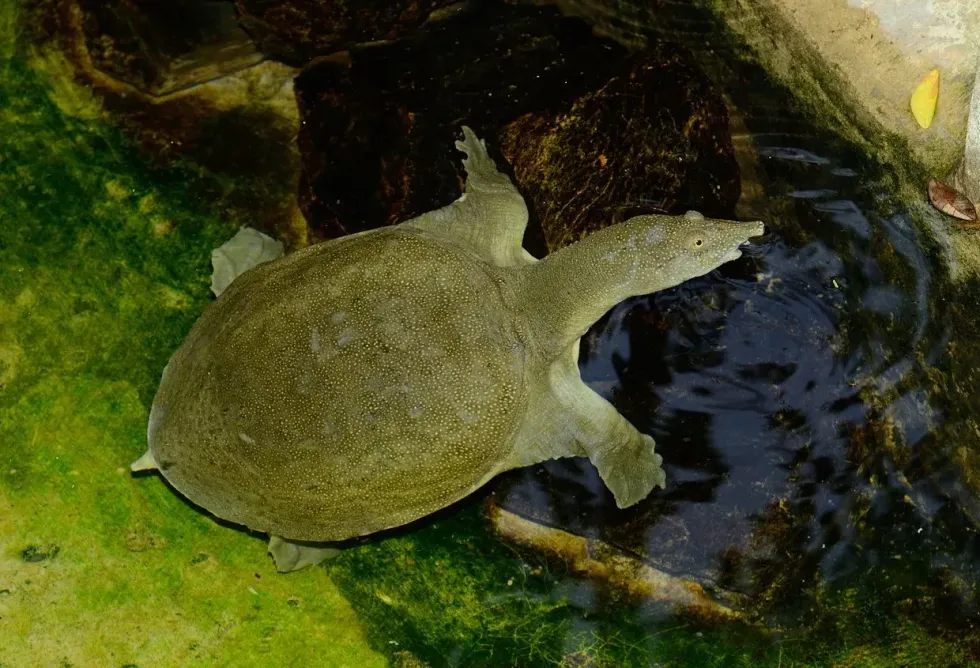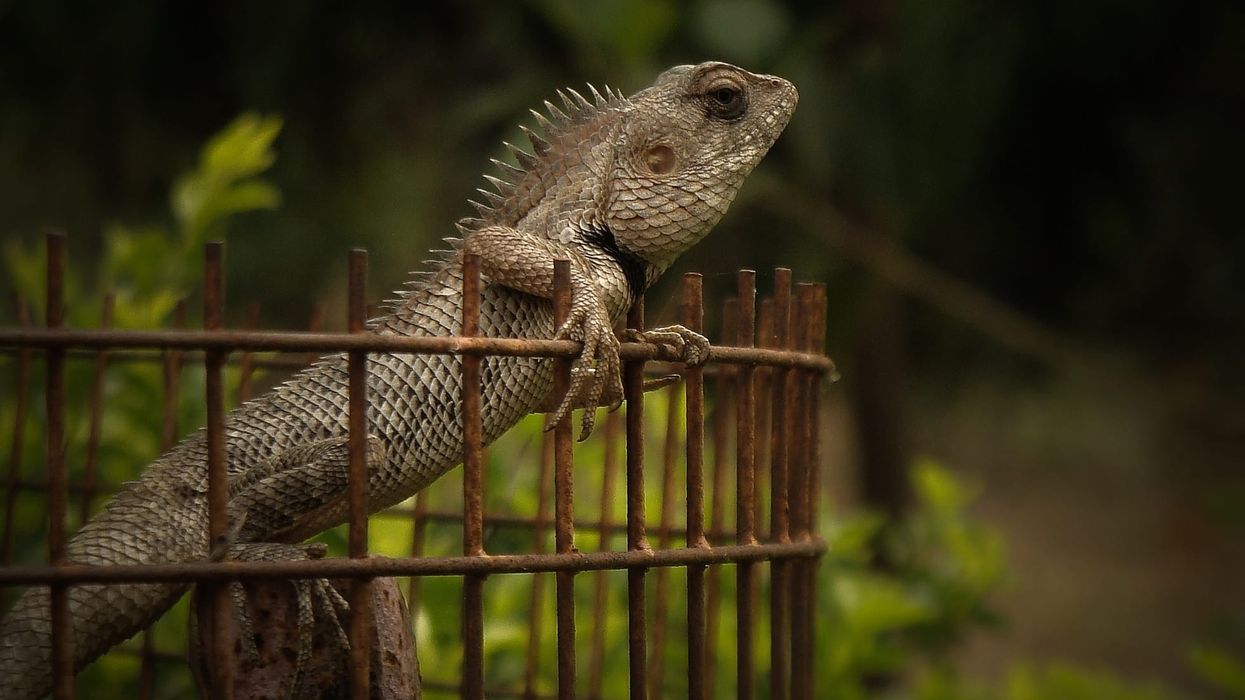Are you looking for an aquatic pet that's not a fish? Then welcome to the world of Chinese softshell turtles!
A little out of the ordinary, this turtle is from a family of turtles that's native to Asia, North America, and Africa and is a keeper if you want your pet to live with you for a long time (as long as 50 years).
The most noticeable aspect is their shell or carapace as it's also called. It has spines or bumps unlike the usual scales or scutes found on the hard shell of normal turtles.
This is because these turtles are, in fact, amphibians that move quicker than the usual turtles, and in water, their webbed feet help them propel faster! So you could say these turtles are an improvised, speedy version of the regular turtle.
If this wasn't enough, then continue scrolling down for more such intriguing facts on the Chinese softshell turtle, and for some more turtle facts, do not forget to check out our articles on the Florida softshell turtle and bog turtle.
Chinese Softshell Turtle Interesting Facts
What type of animal is a Chinese Softshell Turtle?
As its name suggests, the Chinese softshell turtle is a type of turtle that lives on both land and water.
What class of animal does a Chinese Softshell Turtle belong to?
This species belongs to the class of reptiles of the family Trionychidae.
How many Chinese Softshell Turtles are there in the world?
Unfortunately, only a handful of these turtles live in the world, three to four in Vietnam and one in China.
Where does a Chinese Softshell Turtle live?
The softshell turtle lives in freshwater bodies like rivers, lakes, ponds, creeks, and canals. They live in eastern Asian countries, like China and Vietnam, and can also be found in Hawaii.
What is a Chinese Softshell Turtle's habitat?
These softshell turtles prefer a habitat in brackish and freshwater. You can find them in rivers, ponds, creeks with slow currents, and canals in China, whereas in places like Hawaii, they can be found in drainage ditches and marshes.
With a few exceptions that can tolerate saline water, most of their habitat is spanned across slow-moving rivers, streams, and lakes. Moreover, their preferable destination would be the water bodies having muddy and sandy bottoms. Even a wetland would be their favorite!
Who do Chinese Softshell Turtles live with?
Being aggressive, the softshell turtle is often spotted in a pair with a fellow turtle or living alone.
How long does a Chinese Softshell Turtle live?
These soft-shelled turtles live for 20-50 years.
How do they reproduce?
These freshwater turtles reach their sexual maturity between the age of four to six years and then mate underwater or at the water's surface. The female lays about 8-30 eggs at once. These eggs then hatch after two whole months.
What is their conservation status?
The population of this turtle species is rapidly declining and is termed Vulnerable according to IUCN. Several species of this creature are threatened and endangered due to habitat destruction, overhunting, and water pollution; in fact, few of these softshell turtles are also edible. Unfortunately, many countries exploit them for this very reason.
Chinese Softshell Turtle Fun Facts
What do Chinese Softshell Turtles look like?
The most dominant aspect of their appearance is that their soft shell lacks the usual carapace or hard shell; rather, it is more leathery. The shell has almost no bone or horny scales and is just thick skin for protecting them against any predator.
They have a long, elongated neck with a streamlined head and a pointed snout.
Their nostrils are found on top of this snout, enabling them to breathe while being buried in sand, mud, or shallow water. The female also has webbed feet, so look out for this feature too!
How cute are they?
These reptiles belonging to the Trionychidae family have peculiar looks like fleshy lips, streamlined bodies, and a snorkel-like nose, so they might not fit in your adorable animal definition; instead, some of you might find them a little odd-looking creature too!
How do they communicate?
It is unknown how the Pelodiscus sinensis communicate with each other, but studies have shown that the turtles are known to produce low-frequency sounds inaudible to a human ear - secretive, aren't they?
How big is a Chinese Softshell Turtle?
These species of soft-shelled turtles grow up to about 12 in (30 cm) in length and are, in fact, capable of growing up to two feet. Thus, they are about the same size as any other usual turtle you would find on land.
The male species can be identified by their carapace length of 11 in (27 cm). In contrast, the female species have a carapace length of 13 in (33 cm). So the bigger of these amphibians is the female for sure.
How fast can a Chinese Softshell Turtle move?
Beware! The giant softshell turtle is no joke when it comes to sprinting, especially when it's agitated. These species are fast on both water and land, with land speeds being 15 mph (24.1 kph).
How much does a Chinese Softshell Turtle weigh?
These species weigh up to 13.2 lb or around 6 kg.
What are the male and female names of the species?
The Chinese softshell turtle, Pelodiscus sinensis, has no notable names for the male and females, although generally speaking, the males are called male Chinese softshell turtles and the females as female softshell turtles.
What would you call a baby Chinese Softshell Turtle?
Irrespective of the species, a newborn turtle is called a hatchling, as soon as they hatch from their eggs. What would you want to name it?
something that suits an animal that lives on both land and water, perhaps. As a young softshell turtle, it's about the size of half a dollar, give or take, and eventually grows to become healthy, so you could also name it according to its size!
What do they eat?
These predominantly carnivorous species have their diet consisting of remains of fish, insects, mollusks, and crustaceans. They even have seeds of marsh plants found in ponds.
Are they poisonous?
Ever thought about why the neck of the Trionyx sinensis species of reptiles is longer than most of the other turtles you have seen? Well, beware!
Because these turtles bite when troubled and their bite can be pretty aggressive, although the toxicity in their bite isn't a threat, it's better to be safe than sorry. Their clawed jaws and clamped legs do damage that does not necessarily hurt humans other than drawing blood, which can be cured with good first aid.
Would they make a good pet?
If you are in for a little bit of effort from your side to get a long-term pet then you could consider having a soft-shelled turtle.
The reason we are saying so is the number of housing facilities you would have to be ready to provide and maintain if you decide to keep the Pelodiscus sinensis as your pet companion.
According to their weight, a bigger water tank has to be arranged as this freshwater turtle requires a large area to swim. The tank has to have clean water at all times!
So clean that you will have to fit an infiltration system to avoid the turtle species getting infected by fungal and bacterial infections. Try keeping some live aquatic plants as well for these turtles' food.
Yes, they may sound like high-maintenance pets, but once you establish their routine, their different antics and agile swimming would entertain you for many, many years for sure!
Did you know...
A similar species of softshell turtle known as the Spiny softshell turtle has similar characteristics except for an even softer shell! Yes, this turtle is found in North America and has flat and rubbery shells.
This Chinese giant softshell turtle is also known to hibernate during winters while breathing only through their skin and the lining of their throat! I
These reptiles are known to bask on sandbars and large rocks at the water edge and even stay submerged for five hours straight when buried in sand or mud.
How fast do Chinese Softshell Turtles grow?
The exotic Chinese softshell turtle, Pelodiscus sinensis, manages to grow slowly in captivity to about 10-13 in. As they grow older, they tend to be less active and eat less food, so keep them as active as possible with clean water and light!
How to take care of Chinese Softshell Turtles?
These softshell turtles are extremely delightful animals, and to keep them as delightful as they are, you must take dedicated care of them. They are very delicate animals due to their softshell, so a lot of care should be taken in the kind of equipment, shelter, and food you will be providing if you plan to keep them.
Firstly their characteristic and distinct softshell must be kept intact as bites and scrapes can easily damage it, and for that, you need a vast tank filled with lots and lots of sand! Why? Because these species are habituated to burry themselves quite often so you must cater to their needs, right?
Secondly, ensure a low-noise environment as these turtles could get scared around humans like us.
The best way to take care of these creatures is to ensure the softshell turtles get a good protein-based diet in the water itself. The most effective Chinese softshell turtle care you could provide should also include routine veterinary checks, cleaning their water regularly, and checking for good lighting around them to keep the turtles active!
Here at Kidadl, we have carefully created lots of interesting family-friendly animal facts for everyone to discover! Learn more about some other reptiles from our hawksbill sea turtle fun facts, and Russian tortoise surprising facts pages.
You can even occupy yourself at home by coloring in one of our free printable Chinese softshell turtle coloring pages.








